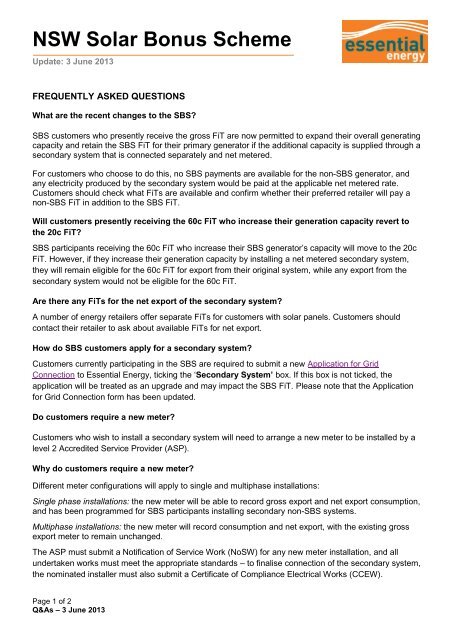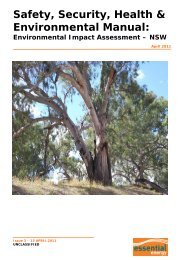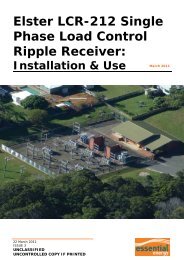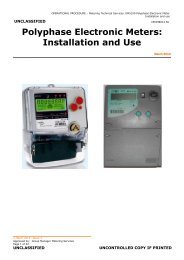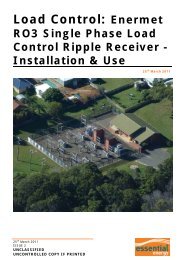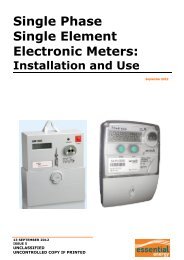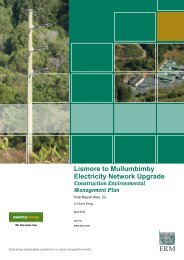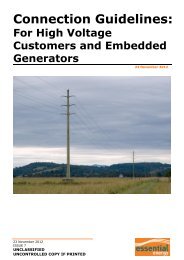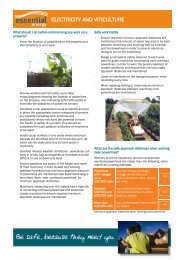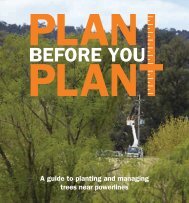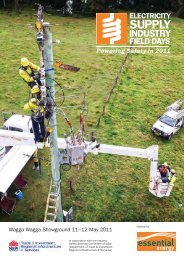SBS - Essential Energy
SBS - Essential Energy
SBS - Essential Energy
Create successful ePaper yourself
Turn your PDF publications into a flip-book with our unique Google optimized e-Paper software.
NSW Solar Bonus Scheme<br />
Update: 3 June 2013<br />
FREQUENTLY ASKED QUESTIONS<br />
What are the recent changes to the <strong>SBS</strong>?<br />
<strong>SBS</strong> customers who presently receive the gross FiT are now permitted to expand their overall generating<br />
capacity and retain the <strong>SBS</strong> FiT for their primary generator if the additional capacity is supplied through a<br />
secondary system that is connected separately and net metered.<br />
For customers who choose to do this, no <strong>SBS</strong> payments are available for the non-<strong>SBS</strong> generator, and<br />
any electricity produced by the secondary system would be paid at the applicable net metered rate.<br />
Customers should check what FiTs are available and confirm whether their preferred retailer will pay a<br />
non-<strong>SBS</strong> FiT in addition to the <strong>SBS</strong> FiT.<br />
Will customers presently receiving the 60c FiT who increase their generation capacity revert to<br />
the 20c FiT?<br />
<strong>SBS</strong> participants receiving the 60c FiT who increase their <strong>SBS</strong> generator’s capacity will move to the 20c<br />
FiT. However, if they increase their generation capacity by installing a net metered secondary system,<br />
they will remain eligible for the 60c FiT for export from their original system, while any export from the<br />
secondary system would not be eligible for the 60c FiT.<br />
Are there any FiTs for the net export of the secondary system?<br />
A number of energy retailers offer separate FiTs for customers with solar panels. Customers should<br />
contact their retailer to ask about available FiTs for net export.<br />
How do <strong>SBS</strong> customers apply for a secondary system?<br />
Customers currently participating in the <strong>SBS</strong> are required to submit a new Application for Grid<br />
Connection to <strong>Essential</strong> <strong>Energy</strong>, ticking the ‘Secondary System’ box. If this box is not ticked, the<br />
application will be treated as an upgrade and may impact the <strong>SBS</strong> FiT. Please note that the Application<br />
for Grid Connection form has been updated.<br />
Do customers require a new meter?<br />
Customers who wish to install a secondary system will need to arrange a new meter to be installed by a<br />
level 2 Accredited Service Provider (ASP).<br />
Why do customers require a new meter?<br />
Different meter configurations will apply to single and multiphase installations:<br />
Single phase installations: the new meter will be able to record gross export and net export consumption,<br />
and has been programmed for <strong>SBS</strong> participants installing secondary non-<strong>SBS</strong> systems.<br />
Multiphase installations: the new meter will record consumption and net export, with the existing gross<br />
export meter to remain unchanged.<br />
The ASP must submit a Notification of Service Work (NoSW) for any new meter installation, and all<br />
undertaken works must meet the appropriate standards – to finalise connection of the secondary system,<br />
the nominated installer must also submit a Certificate of Compliance Electrical Works (CCEW).<br />
Page 1 of 2<br />
Q&As – 3 June 2013
Briefing<br />
3 June 2013<br />
NSW Solar Bonus Scheme (<strong>SBS</strong>) Update<br />
Aren’t customers only permitted to have one type of metering arrangements (gross or net)?<br />
This rule only applies to generation from a system that is participating in the <strong>SBS</strong>. The additional<br />
capacity must be net metered separate to the <strong>SBS</strong> generator. Because no <strong>SBS</strong> payments are available<br />
for secondary systems, they are not classified as participating in the <strong>SBS</strong>.<br />
How do customers get a new meter?<br />
Customers can contact an Accredited Service Provider (ASP) who will order the new meter from<br />
<strong>Essential</strong> <strong>Energy</strong> and arrange its installation. The new meter will be able to support secondary systems.<br />
Installation of the new meter can be arranged through any level 2, category 4, ASP at the customer’s<br />
cost – <strong>Essential</strong> <strong>Energy</strong> will provide ASPs with the meter at no cost. A list of ASPs is available from the<br />
NSW Department of Trade and Investment website:<br />
http://www.trade.nsw.gov.au/energy/electricity/network-connections/contestable/Level-2-ASPs.pdf<br />
What are <strong>Essential</strong> <strong>Energy</strong>’s inspection arrangements for new installations?<br />
<strong>Essential</strong> <strong>Energy</strong> will inspect new renewable energy installations on a sample basis after receiving the<br />
CCEW from your installer and the NoSW from your ASP.<br />
For customers with multi-phase supply (two or three phases), does this impact on the type of<br />
equipment they can install?<br />
Yes, depending on the size of the solar or wind system the customer intends to install. As there are a<br />
number of different scenarios relating to multi-phase installations, customers are encouraged to speak<br />
with their ASP to ensure they receive advice specific to their circumstances.<br />
As a general rule, <strong>Essential</strong> <strong>Energy</strong> recommends that systems up to five (5) kilowatts can be installed on<br />
a single phase, and that inverters for generators (wind or solar) five (5) kilowatts or more are spread<br />
across all available phases. Customers should discuss this information with their ASP or installing<br />
electrician to ensure the best installation for their property.<br />
Who should consider installing a secondary system?<br />
Customers who receive a gross metered 60c FiT may benefit by reducing the amount of energy they<br />
purchase from their retailer as a result of using power that they generate from the secondary system<br />
during sunlight hours.<br />
Customers who receive a gross metered 20c FiT should consider replacing their gross meter with a net<br />
meter because the retail price of their daytime electricity use is likely to exceed the 20c FiT.<br />
Customers on the 20c FiT are permitted to increase their generation capacity up to 10kW and continue<br />
to receive the 20c FiT, so they may not benefit from installing a secondary system. It is important to<br />
ensure that customers seek approval from <strong>Essential</strong> <strong>Energy</strong> by submitting a new application before<br />
increasing generation capacity.<br />
Page 2 of 2<br />
Q&As – 3 June 2013


